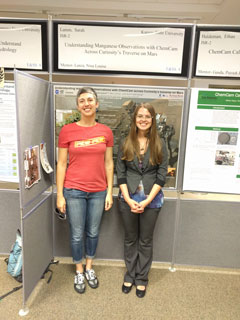September 1, 2016
K-State student's summer break involves geology fieldwork on Mars

Sarah Lamm, undergraduate triple major in geology, chemistry and geography, got the opportunity this summer to get to know Martian rocks up close and personal. Lamm completed a summer internship at Los Alamos National Laboratory working with scientists on the science team for NASA's Curiosity Mars rover mission.
The goal of the mission is to understand if Mars was once habitable; that is, a place where life could have thrived. Lamm's mentor at Los Alamos, Nina Lanza, has been involved in the mission for more than 10 years and has made major contributions to the mission by studying manganese oxides. Lanza identified the oxides using data collected by the Curiosity rover, a car-sized, six-wheeled robot that is exploring Gale Crater on Mars.
Manganese oxides are similar in some ways to iron oxides, or rust, except that the metal within them is manganese, rather than iron. On Earth, key ingredients needed to form manganese oxides typically include oxygen, liquid water and microorganisms. The presence of these minerals on the Martian surface, therefore, suggests that Mars once had more oxygen in its atmosphere and possibly microbial life. However, more work is needed to unambiguously prove how the oxides formed and whether microbes were involved.
Lamm's efforts this summer included tracking manganese abundance in rocks probed by ChemCam, an instrument on Curiosity that analyzes rock chemistry by firing laser pulses and analyzing the spectrum of light that is given off by the vaporized rock target. ChemCam was designed and built at Los Alamos, which continues to run the instrument on Mars on a daily basis.
Lamm presented her findings at the Los Alamos National Laboratory Student Symposium in August, she is a co-author on a presentation that will be given at the annual meeting of the American Geophysical Union in December, and she plans to present her research findings at the Lunar and Planetary Sciences Conference in March 2017.
Over the coming year at K-State, Lamm will continue to make progress on understanding the origin of manganese oxides on Mars. She is carrying out experiments with Matthew Kirk in the geology department to understand how microbial biofilm, the thin slime-like layer many microorganisms live in, affects the properties of manganese oxides.
